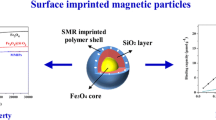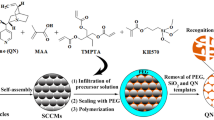Abstract
Pyrene-imprinted microbeads that display molecular recognition towards polyaromatic hydrocarbons (PAHs) were obtained by the aqueous suspension thermopolymerization of a mixture of template, 4-vinylpyridine and divinylbenzene in the molar ratio of 1:8:40. The microbeads were packed into an HPLC column and the retention behaviour of pyrene in the presence of eluents of increasing polarity was investigated by measuring the binding capacity and the imprinting factor. Selectivity was evaluated by eluting pyrene and 22 other related PAHs in the HPLC column when equilibrated with acetonitrile–dichloromethane 4:1 (v/v). Twelve molecular descriptors were calculated for each PAH molecule: MW, the molecular weight; SAS, the solvent-accessible molecular surface area; Svdw, the van der Waals molecular surface area; Vol, the van der Waals molecular volume; MOv, the molecular ovality; RG, the radius of gyration; B/L, the breadth-to-length ratio; μ 2, the square of the total dipole moment; HOMO, the highest occupied molecular orbital; LUMO, the lowest unoccupied molecular orbital; Δorb, the absolute value of the difference between the HOMO and LUMO; log P, the logarithm of the n-octanol–water partition coefficient. Quantitative structure–retention relationships between the logarithm of the capacity factors and these descriptors were searched for using a multiple linear regression (MLR) method. The best regression models obtained showed that the capacity factor correlated well with those molecular descriptors which had structural character, such as logP, while the effect of the molecular descriptors with electronic character was negligible. The results obtained indicate that the molecular recognition of PAHs by the imprinted polymer is controlled by the shape and dimension of the binding sites through hydrophobic interactions.

Retention and imprinting factors of PAHs on the impinted and not-imprinted columns. The area under the lower diagonal line (IF = 1.0) corresponds to the absence of imprinting effect for the interaction between the stationary phase and a given PAH.






Similar content being viewed by others
Abbreviations
- ACP:
-
acenaphthene
- ACY:
-
acenaphthylene
- ACN:
-
acetonitrile
- ANT:
-
anthracene
- BaA:
-
benz[a]anthracene
- BbA:
-
benzo[b]anthracene
- BbF:
-
benzo[b]fluoranthene
- BjF:
-
benzo[j]fluoranthene
- BkF:
-
benzo[k]fluoranthene
- BgP:
-
benzo[ghi]perylene
- BaP:
-
benzo[a]pyrene
- BeP:
-
benzo[e]pyrene
- CHR:
-
chrysene
- CPP:
-
cyclopenta[cd]pyrene
- DeP:
-
dibenzo[ae]pyrene
- DhA:
-
dibenzo[ah]anthracene
- DhP:
-
dibenzo[ah]pyrene
- DlP:
-
dibenzo[al]pyrene
- DCM:
-
dichloromethane
- F:
-
F-test of significance
- FLT:
-
fluoranthene
- FLR:
-
fluorene
- HOMO:
-
highest occupied molecular orbital
- IcP:
-
indeno[1,2,3-cd]pyrene
- IF:
-
imprinting factor
- k:
-
retention factor
- L/B:
-
molecular length-to-breadth ratio
- logP:
-
n-octanol–water partition coefficient
- LUMO:
-
lowest unoccupied molecular orbital
- MIP:
-
molecularly imprinted polymer
- MISPE:
-
molecularly imprinted solid-phase extraction
- MLR:
-
multiple linear regression
- MOv:
-
molecular ovality
- MW:
-
molecular weight
- NAP:
-
naphthalene
- NIP:
-
non-imprinted polymer
- P:
-
significance level of the model
- PAH:
-
polycyclic aromatic hydrocarbon
- PHE:
-
phenanthrene
- PRESS:
-
predicted residual error sum of squares
- PYR:
-
pyrene
- QSRR:
-
quantitative structure–retention relationship
- \(R^{2}_{{{\text{adj}}}} \) :
-
adjusted multiple correlation coefficient
- RG:
-
radius of gyration
- SAS:
-
solvent-accessible molecular surface area
- SEE:
-
standard error of estimate
- Svdw:
-
van der Waals molecular surface area
- Vol:
-
van der Waals molecular volume
- Δorb:
-
difference between the highest occupied molecular orbital and the lowest unoccupied molecular orbital
- μ 2 :
-
square of total dipole moment
References
Harvey RG (eds) (1997) Polycyclic aromatic hydrocarbons. Wiley–VCH, New York
Groopman JD, Kensler TW (1993) Chem Res Toxicol 6:764–770
Wenzl T, Simon R, KleinerJ, Anklam E (2006) Trends Anal Chem 25:716–725
Dickert FL, Besenbock H, Tortschanoff M (1988) Adv Mater 10:149–151
Dickert FL, Forth P, Lieberzeit P, Tortschanoff M (1998) Fresenius J Anal Chem 360:759–762
Dickert FL, Tortschanoff M, Bulst WE, Fischerauer G (1999) Anal Chem 71:4559–4563
Dickert FL, Achatz P, Halikias K (2001) Fresenius J Anal Chem 371:11–15
Kirsch N, Hart JP, Bird DJ, Luxton RW, Mc Calley DV (2001) Analyst 126:1936–1941
Kirsch N, Honeychurch KC, Hart JP, Whitcombe MJ (2005) Electroanalysis 17:571–578
Salinas-Castillo A, Sanchez-Barragan I, Costa-Fernandez JM, Pereiro R, Ballestreros A, Gonzalez JM, Segura-Carretero A, Fernandez-Gutierrez A, Sanz-Mendel A (2005) Chem Commun 3224–3226
Carlson CA, Lloyd JA, Dean SL, Walker NR, Edmiston PL (2006) Anal Chem 78:3537–3542
Luo N, Hatchett DW, Rogers KR (2006) Electroanalysis 18:2180–2187
Lai JP, Niessner R, Knopp D (2004) Anal Chim Acta 522:137–144
Bodor N, Huang MJ (1992) J Pharmaceut Sci 81:272–281
Wise SA, Bonnett WJ, Guenther FR, May WE (1981) J Chromatogr Sci 19:457–465
Catabay A, Okumura C, Jinno K, Pesek JJ, Williamsen E, Fetzer JC, Biggs WR (1998) Chromatographia 47:13–20
Chen S, Fetzer JC, Meyerhoff ME (2001) Fresenius J Anal Chem 369:385–392
Markuszewski M, Kaliszan R (2002) J Chromatogr B 768:55–66
Moon T, Chi MW, Park SJ, Yoon CN (2003) J Liq Chromatogr R T 26:2987–3002
Baczek T, Wiczling P, Marszall M, Vander Heyden Y, Kaliszan R (2006) J Proteome Res 4:555–563
Næs T, Mevik BH (2001) J Chemometrics 15:413–426
Massart DL, Vandeginste BGM, Buydens LMC, De Jong S, Lewi PJ, Smeyers-Verbeke J (1997) Handbook of chemometrics and qualimetrics, Part A. Elsevier Science, Amsterdam
Leo A, Hansch C, Jow PYC (1976) J Med Chem 19:611–615
Pap T, Horvai G (2004) J Chromatogr A 1034:99–107
Jones AC (2003) Ph.D. thesis. University of Wales, Cardiff, UK
Baggiani C, Anfossi L, Giovannoli C, Tozzi C (2004) J Chromatogr B 804:31–41
Acknowledgments
The authors gratefully acknowledge the Water Research Institute of CNR (Milan, Italy) and the Piedmont Regional Agency for Environmental Protection—Food Division (Torino, Italy), which kindly furnished samples of PAHs.
Author information
Authors and Affiliations
Corresponding author
Rights and permissions
About this article
Cite this article
Baggiani, C., Anfossi, L., Baravalle, P. et al. Molecular recognition of polycyclic aromatic hydrocarbons by pyrene-imprinted microspheres. Anal Bioanal Chem 389, 413–422 (2007). https://doi.org/10.1007/s00216-007-1318-8
Received:
Revised:
Accepted:
Published:
Issue Date:
DOI: https://doi.org/10.1007/s00216-007-1318-8




